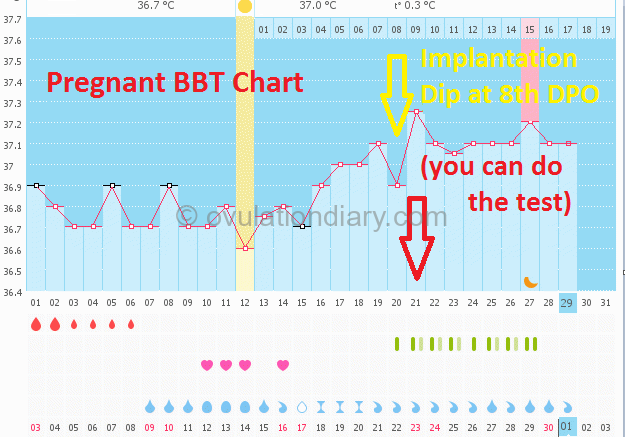
If implantation of the embryo occurred at the 7th DPO (Day Past Ovulation), then the first signs of pregnancy will begin to appear:
- some small amount of blood may be in the discharge (for one day);
- BBT (Basal Body Temperature) drops by 0.2-0.4 °C or 0.36–0.72 °F;
- aching pain in lower abdomen or lower back; weakness and sensitivity to odors.
This article describes what happens to the female body and the fertilized egg during this period. And provides more details about the symptoms of pregnancy, which are most common on the 6th and 7th day past ovulation.
Embryo preparation and implantation
On the sixth to ninth day after ovulation, the blastocyst loses its shiny shell, which was used to easily glide along the fallopian tube for the first four to five days.
At this moment, the endometrium thickness is at its maximum and comprehensively surrounds the embryo — this provides proper contact between the endometrium and the embryo.
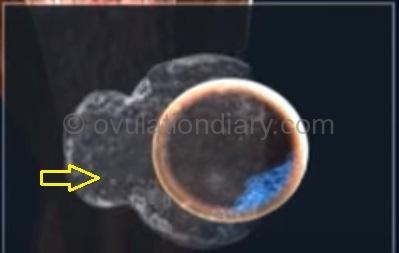
The outer cell layer of the ovum (trophoblast) releases tentacle-shaped processes and is implanted in the uterine epithelium. This process continues until the embryo is completely immersed in the nutrient tissue of the endometrium. This process is called — implantation.
From this moment on, starts the production of hCG and pregnancy can be detected by tests.
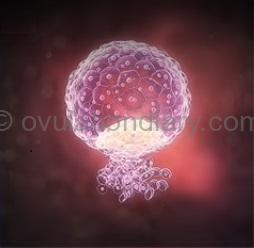
![]() This is interesting (!): The timing of implantation may vary slightly. In most cases, the implantation period is after 7th-10th DPO, but there are cases of implantation on the 4th – 6th or 11th–12th DPO.
This is interesting (!): The timing of implantation may vary slightly. In most cases, the implantation period is after 7th-10th DPO, but there are cases of implantation on the 4th – 6th or 11th–12th DPO.
What are the most common signs of pregnancy a week after ovulation?
After implanting into the uterus, the embryo gives an official signal to the body (in the form of hCG) to get ready for bearing. It primarily affects the corpus luteum, which is formed after the ovum leaves the follicle. Now it will intensively produce progesterone in order to:
- stop rejection of the uterine endometrium and the onset of menstruation;
- relieve uterine tone and stop muscle contraction;
- provide a rush of blood and increased blood circulation in the pelvic organs;
- stimulate fluid retention and the development of mammary glands.
Most commonly, the embryo attachment process is accompanied by pain in the lower abdomen. Sometimes it is projected into the ovaries or spreads to the back and it might seem like lumbar (lower back) muscle strains.
Pain could be of single occurrence or prolonged. For example, starting from the fourth DPO and lasts through the entire second phase until the delay.
The following are the most common signs of pregnancy, at which point it is sensible to do an ultrasensitive pregnancy test:
- The day after implantation bleeding;
- If on the sixth or seventh day after ovulation, the lower abdomen is aching as before menstruation, there may even be a slight tingling or burning sensation, and the next day everything suddenly stops;
- At the first signs of toxicosis (ordinary smells are sickening or disgusting);
- Changes in the BBT chart.
There are other signs of early pregnancy. In most cases, they begin on the 8th-14th DPO. You can read more about them in this article on ovulationdiary.com.
Basal body temperature on the 6th and 7th day past ovulation
Let me remind you that the basal body temperature (BBT) chart is valuable for its dynamics, and not for absolute indicators. If it is not possible to compare indicators with previous cycles, do not expect an objective assessment of the current results. And there is no need to “start” measuring at that stage.
After conception, the normal BBT will remain stably high, approximately 0.3–0.5 degrees higher than the average value of phase I. This is a common manifestation of the pregnancy-supporting hormone – progesterone.
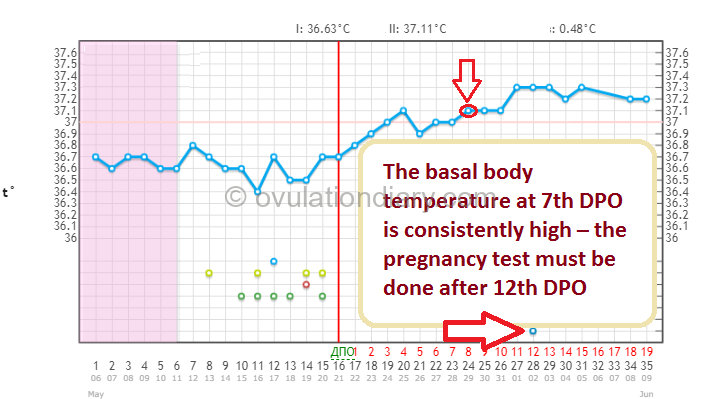
![]() Note (!): Process of embryo implantation can be asymptomatic (even painless) and without any changes in the BBT chart. In this case, the test could be done at the 12th-14th DPO, preferably later, after the 1st day of the delay, but only if BBT remains constantly elevated.
Note (!): Process of embryo implantation can be asymptomatic (even painless) and without any changes in the BBT chart. In this case, the test could be done at the 12th-14th DPO, preferably later, after the 1st day of the delay, but only if BBT remains constantly elevated.
In what cases could the test be done before day X?
- if there was a sharp drop in basal body temperature with growth the next day;
- if there was no retreat, but at some point the BBT became even higher and more stable (compared to phase II) by about 0.2-0.3 degrees. This phenomenon is called the third phase in the BBT chart.
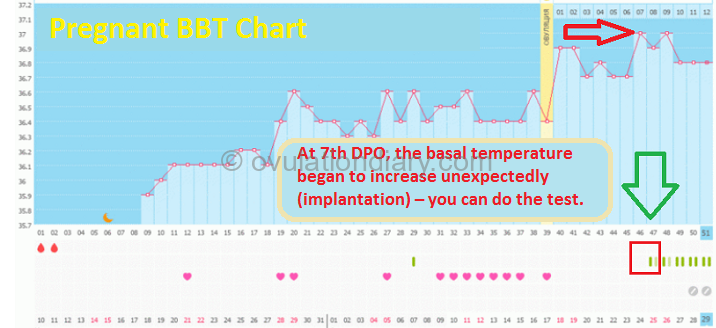
All of the listed signs and specific symptoms could be evaluated after the 7th DPO. You can do the test the morning after those symptoms have occurred.
If a very, very pale line appeared on the test — a ghost, it is better to quietly postpone your joy until the day after tomorrow and repeat the test. In pregnancy, the hCG level doubles every two days and if the second strip appears brighter, the pregnancy is confirmed.
If the test is negative, do not be discouraged. This happens when the hormone has not yet gotten into the urine. Repeat the test in a couple of days or test your blood for general hCG (this is the most accurate way of testing hCG level).
![]() Note (!): Watch your condition, not anxiously with constant worry, but with joyful and happy anticipation, as if the pregnancy had already been confirmed.
Note (!): Watch your condition, not anxiously with constant worry, but with joyful and happy anticipation, as if the pregnancy had already been confirmed.
If this time there is no result, but there is definitely ovulation – there might be another reason. This article elaborates in detail on reasons for the absence of pregnancy and the steps that should definitely be taken.
To everyone planning – I wish you a successful pregnancy and healthy babies!

